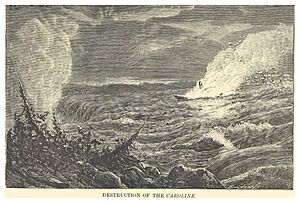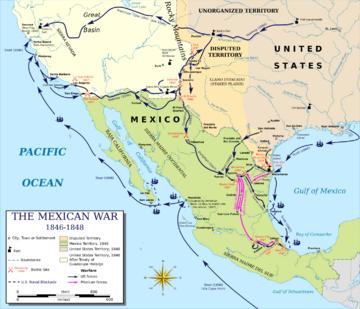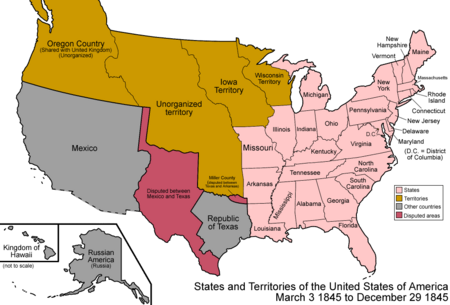History of U.S. foreign policy, 1829–1861 facts for kids
The history of U.S. foreign policy from 1829 to 1861 is about how the United States dealt with other countries. This time period covers the presidencies of Andrew Jackson, Martin Van Buren, William Henry Harrison, John Tyler, James K. Polk, Zachary Taylor, Millard Fillmore, Franklin Pierce, and James Buchanan.
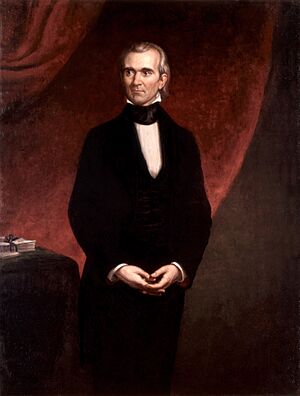
During these years, the U.S. grew a lot. It added the Republic of Texas, gained huge lands from Mexico after winning the Mexican–American War, and shared the Oregon Country with the United Kingdom of Great Britain and Ireland. This era started when Andrew Jackson became president in 1829. It ended in 1861 when the American Civil War began.
President Jackson wanted to increase trade and settle old money claims. He made a deal with Britain to open ports in Canada and the British West Indies for U.S. ships. After Texas became independent from Mexico in 1835, it wanted to join the U.S. But Presidents Jackson and Van Buren said no. They worried it would cause arguments about slavery and possibly lead to war with Mexico. Many Texans owned slaves, and people in the North did not want another slave state.
However, President Tyler made adding Texas his main goal. This became a big topic in the 1844 United States presidential election. After James K. Polk won the election, the U.S. annexed Texas. This caused problems at the Texas-Mexico border, leading to the Mexican-American War in 1846. The U.S. won the war and gained control of Alta California and New Mexico through the Treaty of Guadalupe Hidalgo.
Relations with Britain became tense during the Rebellions of 1837–1838 in Canada. But President Van Buren and General Winfield Scott helped avoid a war. In 1842, Britain and the U.S. signed the Webster–Ashburton Treaty, which solved several border issues. The two countries also agreed to divide the Oregon Country at the 49th parallel in the Oregon Treaty of 1846. In 1853, the U.S. bought more land from Mexico in the Gadsden Purchase. This created the borders of the contiguous United States we see today.
The Polk, Pierce, and Buchanan administrations tried to get Cuba from Spain. But Spain and anti-slavery groups in the U.S. stopped them. The U.S. also became more involved in the Pacific Ocean in the 1840s and 1850s. In 1842, President Tyler said the U.S. would not allow European countries to colonize the Hawaiian Islands. The Perry Expedition in 1853–1854 opened up trade with Japan. This event eventually led to big changes in Japan.
Contents
Leaders and Their Goals
Jackson's Presidency (1829–1837)
Democrat Andrew Jackson became president in 1829. He chose Martin Van Buren as his Secretary of State. Jackson's main foreign policy goals were to expand trade and settle claims for damages.
Jackson's government was the first to actively promote trade with Asia. The U.S. Navy helped protect American merchant ships. It also explored dangerous parts of the Pacific Ocean. The State Department worked to create treaties to protect American trade.
Van Buren's Presidency (1837–1841)
Martin Van Buren took office in 1837. He kept many of Jackson's team members, including Secretary of State John Forsyth. Van Buren was very involved in foreign affairs. He wanted peace with other countries and harmony at home.
Harrison and Tyler's Presidencies (1841–1845)
Whig William Henry Harrison became president in 1841. He died just one month later. John Tyler then became president. Tyler's domestic plans faced problems in Congress. So, he focused on foreign policy with his Secretary of State, Daniel Webster.
After Webster resigned, Abel P. Upshur became Secretary of State. He focused on Tyler's main goal: annexing the Republic of Texas. After Upshur died, John C. Calhoun took over as Secretary of State.
Polk's Presidency (1845–1849)
Democrat James K. Polk became president in 1845. He chose James Buchanan as Secretary of State. Polk wanted to expand the U.S. and gain new lands in the west.
Taylor and Fillmore's Presidencies (1849–1853)
Whig Zachary Taylor became president in 1849. He appointed John M. Clayton as Secretary of State. Taylor and Clayton did not have much diplomatic experience. They focused on keeping peace. Taylor died in 1850. Millard Fillmore then became president. Fillmore appointed Daniel Webster as Secretary of State. Webster became Fillmore's most important advisor.
Pierce's Presidency (1853–1857)
Democrat Franklin Pierce became president in 1853. He appointed William L. Marcy as Secretary of State. Pierce's administration supported the "Young America" idea, which favored U.S. expansion. Marcy wanted American diplomats to show a unique American image abroad. He also defended an Austrian refugee who wanted to become a U.S. citizen.
Buchanan's Presidency (1857–1861)
Democrat James Buchanan became president in 1857. He wanted to make the U.S. a stronger power in Central America. He also hoped to gain Cuba and parts of Mexico. However, anti-slavery forces in Congress stopped his plans to acquire new slave territories.
Trade and Money Claims
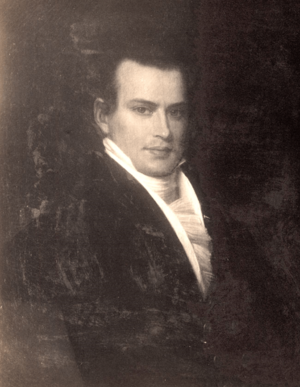
Jackson's government made a trade deal with Great Britain. This opened British ports in the West Indies and Canada to American goods. This was a big success for Jackson. The U.S. also made trade agreements with Russia, Spain, the Ottoman Empire, and Siam. American exports grew a lot during this time. Jackson also used the navy to protect American trade ships in places like the Falkland Islands and Sumatra.
Another main goal for Jackson was to settle claims for damages. The biggest issue was a debt that France owed for damages caused by Napoleon years earlier. France kept delaying payment. Jackson made strong demands, and his minister to France, William Cabell Rives, finally got the payment in 1836. The U.S. also settled smaller claims with Denmark, Portugal, and Spain.
Relations with Britain (1829–1861)
Canadian Rebellions
British subjects in Canada rebelled in 1837 and 1838. Many rebels fled to New York. A Canadian leader, William Lyon Mackenzie, started gathering volunteers in Buffalo, New York. They planned to invade Canada. The British burned an American supply ship called the Caroline. One American was killed. Many Americans wanted to declare war.
President Van Buren wanted to avoid war. He sent General Winfield Scott to the border. Scott told Americans to seek a peaceful solution. The U.S. government would not support Americans attacking the British. In 1838, the president declared that the U.S. would remain neutral. Congress passed a law to stop Americans from joining foreign conflicts.
Some secret groups, called "Hunters' Lodges", still tried to overthrow British rule in Canada. They launched attacks in Canada. But the U.S. government enforced its neutrality laws. The "Patriot War" ended after two failed expeditions in 1839. Van Buren's actions helped build good relations between the U.S. and Canada later on.
Aroostook Conflict
A new problem came up in 1838 over disputed land on the Maine–New Brunswick border. Both American and New Brunswick lumberjacks were cutting timber there. Tensions grew, and both sides arrested each other's citizens. It almost led to war. The American press called for war. Congress even allowed for 50,000 troops if needed.
Van Buren did not want war. He met with the British minister to the U.S. They agreed to solve the border issue peacefully. Van Buren also sent General Scott to the area. Scott successfully convinced everyone to settle the border issue through talks.
Webster–Ashburton Treaty
Secretary of State Webster wanted to make a big treaty with Great Britain. This would end the tensions between the two countries. Relations were bad after the Caroline incident and the Aroostook War. Webster and Tyler wanted better relations with Britain. This would help the U.S. economy and gain British support for annexing Texas.
British diplomat Lord Ashburton came to Washington in 1842. After months of talks, the U.S. and Britain signed the Webster–Ashburton Treaty in August 1842. The treaty clearly set the northern border of Maine and other parts of the U.S.-Canada border. It also included a promise by the U.S. to fight the Atlantic slave trade.
The Senate approved the treaty. It became popular in America. This treaty was an important step in improving relations between the U.S. and Britain after the War of 1812. It showed that both countries accepted sharing control of North America. American expansionists then focused on Mexico.
Clayton–Bulwer Treaty
The Taylor administration's big foreign policy achievement was the Clayton–Bulwer Treaty of 1850. This treaty was about a possible canal through Central America connecting the Atlantic and Pacific oceans. Both the U.S. and Britain agreed not to claim control over any canal built in Nicaragua. This treaty helped build a stronger alliance between the two nations.
Pierce Administration and Britain
During Pierce's presidency, relations with Britain were tense. There were disagreements over American fishing rights in Canada and both countries' goals in Central America. Secretary of State Marcy made a trade agreement with Britain. This treaty, which Pierce hoped would lead to the U.S. annexing Canada, was approved in 1854.
The Clayton–Bulwer Treaty of 1850 had not stopped Britain from expanding its influence in Central America. Buchanan tried to convince Britain to give up its territories there. Britain was ready to give up most of its claims. But an incident in the British-protected port of Greytown made relations worse. An American company employee was murdered. Pierce ordered a U.S. ship to Greytown, and the ship destroyed the town. Despite this, British merchants did not want war with the U.S. So, no war broke out.
Texas and Its Annexation
Independence and Recognition
Jackson wanted to expand the U.S. to the west. He tried to buy the Mexican state of Coahuila y Tejas, but Mexico refused. Mexico had invited American settlers to this area. Between 1821 and 1835, 35,000 Americans moved there. Most came from the Southern U.S. and brought slaves. In 1830, Mexico banned immigration to Texas. The American settlers became unhappy with Mexican rule.
In 1835, American settlers and local Texans fought for independence from Mexico. This was the Texas Revolution. Texan leader Stephen F. Austin asked Jackson for military help, but the U.S. stayed neutral. By May 1836, Texas had won its independence and formed the Republic of Texas. The new Texas government wanted the U.S. to recognize it and annex it.
People in the U.S. who opposed slavery strongly disagreed with annexing Texas because slavery was present there. Jackson was not sure Texas could stay independent from Mexico. He also did not want to make Texas an issue about slavery during the 1836 election. After the election, Jackson officially recognized the Republic of Texas.
Van Buren wanted peace. When Texas asked to be annexed in 1837, he said no. He worried about constitutional issues and war with Mexico. He also feared it would cause a fight over slavery. Texas withdrew its offer in 1838. Mexico still saw Texas as part of its country.
Tyler Administration and Texas
In 1843, President Tyler focused on Texas. He believed Britain wanted Texas to abolish slavery. This would hurt the Southern U.S. Tyler and his Secretary of State, Abel Upshur, secretly talked with the Texas government. They promised military protection from Mexico if Texas agreed to annexation.
Upshur spread rumors about British plans for Texas. This was to gain support from Northerners, who were worried about adding a new slave state. Texas leaders were careful, fearing the U.S. Senate might reject any treaty. But they finalized an annexation treaty by early 1844. Texas would join as a territory, and the U.S. would take on its public lands and debt.
After Upshur died, Tyler appointed John C. Calhoun as Secretary of State. Northerners saw Calhoun as a symbol of slavery expansion. This hurt Tyler's efforts to separate Texas from the slavery issue. In April 1844, Calhoun and Texas negotiators signed the annexation treaty.
When the treaty became public, Whigs opposed it. They did not want to help Tyler. Also, anti-slavery groups and those who feared war with Mexico opposed it. Mexico had said it would see annexation as an act of war. Both Henry Clay and Van Buren, who were leading candidates for president, spoke out against annexation. The Senate rejected the treaty in June 1844.
Tyler then tried a different approach. He sent the treaty to the House of Representatives. He hoped Congress would annex Texas by a simple majority vote in both houses, not a two-thirds vote in the Senate. The debate over Texas was a major topic in 1844. Former President Andrew Jackson, who strongly supported annexation, convinced James K. Polk to welcome Tyler back into the Democratic Party. Tyler then dropped out of the presidential race and supported Polk.
During the 1844 campaign, Democrats argued that Texas and Oregon rightfully belonged to the U.S. Clay argued that annexing Texas would lead to war with Mexico and increase tensions over slavery. Polk won the election.
Annexing Texas
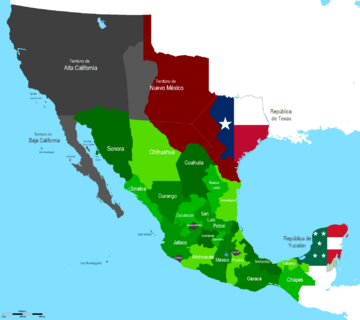
After the election, Tyler told Congress that most Americans wanted immediate annexation. Congress debated annexation from December 1844 to February 1845. Polk's support helped unite Democrats behind Tyler's plan. In late February 1845, both the House and Senate approved a resolution to offer annexation to Texas. On March 1, Tyler signed the bill into law.
Polk's first big decision was whether to stop Tyler's offer to Texas. He let the offer continue. He also kept Andrew Jackson Donelson, the U.S. Ambassador to Texas. Donelson tried to convince Texas leaders to accept the offer. In July 1845, a meeting in Austin, Texas, approved the annexation. In December 1845, Polk signed a resolution annexing Texas. Texas became the 28th state. This increased tensions with Mexico, which had never recognized Texas's independence.
Mexican–American War
Why the War Started
The U.S. was the first country to recognize Mexico's independence. But relations worsened in the 1830s. The U.S. wanted Mexico to pay for damages caused to American ships and citizens. Mexico believed the U.S. wanted its territory. Mexico also thought many American claims were fake.
The possible annexation of Texas made things much worse. Mexico still saw Texas as part of its country. Texas claimed all land north of the Rio Grande River. Mexico said the Nueces River was the correct border. The U.S. had a much larger population and economy than Mexico. But Mexico was ready to fight for Texas.
The Mexican province of Alta California was largely independent. It had weak defenses. Polk really wanted California. He saw it as new land and a way to trade with Asia. He feared Britain or another European power would take California if Mexico kept it. In late 1845, Polk sent diplomat John Slidell to Mexico. Slidell was to get Mexico to accept the Rio Grande border. He was also allowed to buy California for $20 million and New Mexico for $5 million. Polk also sent Lieutenant Archibald H. Gillespie to California. His orders were to start a pro-American rebellion there.
War Breaks Out
After Texas was annexed in 1845, both Mexicans and Americans thought war was likely. Polk started preparing. He sent an army led by General Zachary Taylor to Texas. Taylor was told not to start a war, but to respond if Mexico attacked. Mexican President José Joaquín de Herrera was open to talks. But a Mexican council refused to accept Slidell as an ambassador. In December 1845, Herrera's government fell. This was largely because he was willing to talk about selling parts of Mexico.
Since talks seemed unlikely, Secretary of War Marcy ordered General Taylor to move to the Rio Grande River. Polk also started preparing to support Antonio López de Santa Anna, a Mexican general in exile. Polk hoped Santa Anna would sell parts of California. In March 1846, Slidell left Mexico after his demands were refused. He returned to Washington in May 1846. He told Polk that talks with Mexico would not work. Polk saw this as an insult and a reason for war. He prepared to ask Congress to declare war.
In late March 1846, General Taylor reached the Rio Grande. His army camped across the river from Matamoros, Tamaulipas. In April, a Mexican general demanded Taylor return to the Nueces River. Taylor started blocking Matamoros. A fight on the north side of the Rio Grande resulted in American soldiers being killed or captured. This was called the Thornton Affair.
Polk heard about the fighting. He told Congress that Mexico had invaded American territory by crossing the river. Polk said a state of war already existed. He asked Congress to give him power to end the war. Polk made it sound like the war was a necessary defense. He mentioned Slidell went to Mexico to recognize Texas annexation. But he did not mention wanting to buy California.
Some Whigs, like Abraham Lincoln, disagreed with Polk's story. But the House approved a resolution to call up 50,000 volunteers. In the Senate, war opponents also questioned Polk. But the resolution passed 40–2. This marked the start of the Mexican–American War. Many lawmakers who doubted the war still voted for it. They feared losing political support if they opposed it.
Early War Events
In May 1846, Taylor led U.S. forces in the Battle of Palo Alto. This was the first major battle. The next day, Taylor won the Battle of Resaca de la Palma. This stopped Mexico from invading the U.S. Taylor's army moved south towards Monterrey. In September 1846, Taylor defeated a Mexican force in the Battle of Monterrey. But he let the Mexican forces leave, which upset Polk.
Meanwhile, Winfield Scott, the army's highest-ranking general, was offered command of the war. Polk, War Secretary Marcy, and Scott agreed to capture northern Mexico and then seek peace. However, Polk and Scott did not trust each other. This was partly because Scott was a Whig and had been a rival of Andrew Jackson. Polk wanted both Whigs and Democrats in important war roles. Scott also angered Polk by opposing Polk's plan to add more generals. Polk ordered Scott to stay in Washington, leaving Taylor in command in Mexico. Polk also ordered a U.S. naval officer to let Santa Anna return to Mexico from exile. He also sent an army group led by Stephen W. Kearny towards Santa Fe.
While Taylor fought in the east, U.S. forces took control of California and New Mexico. Army Captain John C. Frémont led settlers in Northern California in an attack. This started the Bear Flag Revolt. In August 1846, American forces under Kearny captured Santa Fe, the capital of New Mexico. He took Santa Fe without a fight. After setting up a government in New Mexico, Kearny went west to help conquer California. After Kearny left, Mexicans and Puebloans rebelled. But U.S. forces stopped the uprising. Around the same time, Commodore Robert F. Stockton landed in Los Angeles and announced California's capture. Local Californians rebelled, but Stockton and Kearny put down the revolt.
Wilmot Proviso and Slavery Debate
Opposition to the war grew among Whigs after 1845. Some Democrats also lost their excitement. In August 1846, Polk asked Congress for $2 million. He hoped to use this money to buy California from Mexico. Polk's request caused opposition. He had never publicly said he wanted to annex parts of Mexico (besides Texas).
A new Democratic Congressman, David Wilmot, proposed an amendment. This "Wilmot Proviso" would ban slavery in any new lands gained from Mexico. The bill, including the Wilmot Proviso, passed the House. It was supported by Northern Whigs and Northern Democrats. Wilmot himself was against slavery. But many pro-slavery Northern Democrats voted for the bill because they were angry at Polk. The debate over Oregon, tariffs, and Van Buren's dislike of Polk all added to Northern anger. The bill, including the slavery ban, failed in the Senate. But the Wilmot Proviso brought the slavery debate into national politics.
Later War Events
Santa Anna returned to Mexico City in September 1846. He said he would fight the Americans. Polk realized Santa Anna was not trustworthy. Since Mexico refused his peace offers, Polk ordered an American landing in Veracruz. This was Mexico's most important port on the Gulf of Mexico. Polk decided a force would land in Veracruz and then march on Mexico City. Taylor was told to stay near Monterrey. Polk reluctantly chose Winfield Scott to lead the attack on Veracruz.
In March 1847, Polk learned that Taylor had ignored orders. Taylor had continued marching south and captured the northern Mexican town of Saltillo. Taylor's army had defeated a larger Mexican force led by Santa Anna in the Battle of Buena Vista in February 1847. Taylor became famous for this victory. But the fighting in that area was not decisive. Taylor withdrew back to Monterrey. Meanwhile, Scott landed in Veracruz and quickly took control of the city. After capturing Veracruz, Polk sent Nicholas Trist to negotiate a peace treaty with Mexican leaders. Trist was told to seek California, New Mexico, and Baja California. He also had to get Mexico to recognize the Rio Grande as the Texas border.
In April 1847, Scott defeated Santa Anna's forces at the Battle of Cerro Gordo. This cleared the way to march on Mexico City. In August, Scott defeated Santa Anna again. Scott's army was then ready to attack Mexico's capital. Santa Anna made a truce with Scott. The Mexican foreign minister told Trist they were ready to talk peace. But the two sides disagreed on terms. Mexico would only give up parts of California. It still refused the Rio Grande border. While talks continued, Scott captured Mexico City.
In the U.S., there was a big debate about how much Mexican land to take. Some Whigs, like Henry Clay, wanted only to settle the Texas border. Some expansionists wanted to annex all of Mexico. Polk was frustrated by the slow talks. He heard rumors that Trist was willing to give up on the Rio Grande border. Polk ordered Trist to return to Washington. Polk decided to occupy large parts of Mexico and wait for a Mexican peace offer.
Peace: The Treaty of Guadalupe Hidalgo
In September 1847, Manuel de la Peña y Peña became President of Mexico. He was willing to negotiate based on Polk's terms. In November 1847, Trist received Polk's order to return to Washington. After thinking about it, Trist decided to negotiate with the Mexican government anyway. He knew Polk had no plans to send a new envoy. Trist felt he could not miss the chance to end the war. Polk was angry, but he let Trist try to negotiate a treaty.
In January 1848, Trist met with Mexican officials in Guadalupe Hidalgo. Trist allowed Mexico to keep Lower California. But he successfully got the important harbor of San Diego included in the cession of Upper California. The Mexican team agreed to recognize the Rio Grande border. Trist agreed that the U.S. would pay American claims against Mexico. The two sides also agreed that Mexicans in the new territory could leave or become U.S. citizens. The U.S. would also prevent Native American raids into Mexico. Finally, the U.S. would pay Mexico $15 million. On February 2, 1848, Trist and the Mexican team signed the Treaty of Guadalupe Hidalgo.
Polk received the treaty on February 19. He decided he had to accept it. If he refused, Congress, now controlled by Whigs, might not fund the war. On March 10, the Senate approved the treaty 38–14. The Senate made some changes. Polk worried Mexico would reject the new terms. But on June 7, Polk learned Mexico had approved the treaty. Polk declared the treaty in effect on July 4, 1848, ending the war.
The Mexican Cession added 600,000 square miles to the U.S. This included a long Pacific coastline. The treaty also recognized Texas annexation and U.S. control over the disputed land between the Nueces River and the Rio Grande. Mexico received $15 million. The war cost nearly 14,000 American lives and 25,000 Mexican lives. It also cost the U.S. about $100 million. Except for the land gained in the 1853 Gadsden Purchase, these land gains set the modern borders of the Contiguous United States.
Oregon Country and Expansion
Oregon Boundary Dispute
The Tyler administration wanted a treaty with Britain to divide the Oregon Country. Both countries had shared this land since 1818. They had tried to agree on a border before but failed. The British wanted the border to follow the 49th parallel until it met the Columbia River. Then the river would be the border. For the U.S., a main goal was to get a deepwater port in the Puget Sound. This port was north of the Columbia River but south of the 49th parallel. Tyler also thought getting part of Oregon would make annexing Texas more acceptable to Northerners. More and more Americans were moving to Oregon Country. So, its status became a bigger issue. Some Americans wanted to claim the entire territory, up to the 54°40′ parallel.
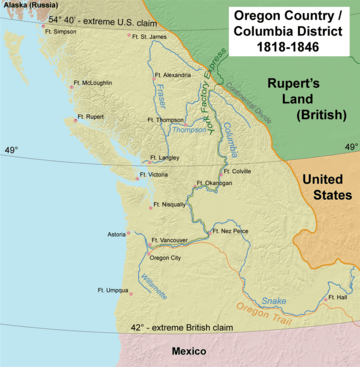
Talks about Oregon continued under Polk. Both Britain and the U.S. wanted a good compromise. But they also saw the territory as important for power in North America. In his first speech, Polk said the American claim to the land was "clear and unquestionable." This made British leaders threaten war if Polk tried to take the whole territory. Polk had not claimed the entire territory, but his party wanted it. Polk did not want war with Britain. So, he and Buchanan started talks. Polk again suggested dividing the land at the 49th parallel. The British rejected this. Secretary of State Buchanan worried about fighting two wars, with Mexico and Britain. But Polk was willing to risk war for a good deal.
In December 1845, Polk asked Congress to approve giving Britain a one-year notice to end the joint occupation of Oregon. He used the Monroe Doctrine to show America's goal of keeping European powers out. This was the first major use of the doctrine since 1823. Congress approved the notice in April 1846. They hoped the dispute would be settled peacefully. The British Foreign Secretary, Lord Aberdeen, asked the U.S. to restart talks. But Polk would only do so if Britain made a proposal.
Britain was moving towards free trade. So, good trade relations with the U.S. were more important to Aberdeen than a distant territory. In February 1846, Polk let Buchanan tell the American ambassador to Britain that Polk would like a British proposal based on dividing the land at the 49th parallel. In June 1846, the British presented an offer. It called for a border at the 49th parallel. Britain would keep all of Vancouver Island. British subjects would have limited navigation rights on the Columbia River until 1859. Polk and most of his cabinet were ready to accept. But Buchanan, surprisingly, wanted the U.S. to seek all of Oregon.
Polk sent the treaty to the Senate for approval. The Senate approved the Oregon Treaty 41–14. Some senators who wanted the whole territory opposed it. Polk's willingness to risk war with Britain had scared many. But his tough negotiation tactics may have won the U.S. better terms from the British.
Expansion in the 1850s
Gadsden Purchase
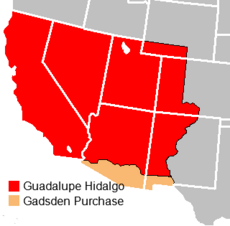
Secretary of War Jefferson Davis wanted a southern route for a transcontinental railroad. He convinced President Pierce to send James Gadsden to Mexico to buy land for it. Gadsden was also to renegotiate parts of the Treaty of Guadalupe Hidalgo. This treaty required the U.S. to stop Native American raids into Mexico from New Mexico Territory. Pierce allowed Gadsden to offer $50 million for large parts of Northern Mexico, including all of Baja California.
Gadsden made a smaller deal with Mexican President Antonio López de Santa Anna in December 1853. He bought a part of the Mexican state of Sonora. Talks almost failed because of William Walker's unauthorized expedition into Mexico. So, a clause was added to stop future attempts like that. The treaty also said the U.S. would pay American claims against Mexico. It also gave Americans access across the Isthmus of Tehuantepec. Pierce was disappointed with the treaty.
Northern lawmakers did not like the treaty. Many saw it as a way to benefit slave states. Congress reduced the Gadsden Purchase to the area that is now southern Arizona and part of southern New Mexico. The original treaty had given the U.S. a port on the Gulf of California. Congress also lowered the payment to Mexico from $15 million to $10 million. Pierce did not fully support the final version of the treaty. But it was approved anyway. This purchase gave the contiguous United States its current borders.
Cuba and Expansion
In 1848, President Polk allowed his ambassador to Spain to offer up to $100 million to buy Cuba. This was a huge amount of money then. Cuba was close to the U.S. and had slavery. So, Southerners liked the idea, but Northerners did not. Spain was making a lot of money from Cuba. So, the Spanish government refused Polk's offer. Polk wanted Cuba, but he did not support Narciso López's plan to invade Cuba.
Like many presidents, Pierce hoped to annex Cuba. It had rich sugar plantations, was important for trade in the Caribbean Sea, and could become a new slave state. Pierce appointed Pierre Soulé as his minister to Spain. Soulé quickly angered the Spanish government. After the Black Warrior Affair, where Spain seized a U.S. merchant ship, Pierce thought about invading Cuba. But he decided to focus on buying Cuba from Spain.
Ambassadors Soulé, Buchanan, and John Y. Mason wrote a document. It suggested buying Cuba for $120 million. It also tried to justify taking Cuba by force if Spain refused. This document, called the Ostend Manifesto, was meant only for Pierce's administration. It was not meant for the public. But when it was published, Northerners were angry. They saw it as a plan to get another slave territory. The publication of this document hurt the idea of "Manifest Destiny" that the Democratic Party often supported.
Buchanan's Plans
Buchanan wanted to make the U.S. the main power in Central America. He hoped to change the Clayton–Bulwer Treaty, which he thought limited U.S. influence. He also wanted to create American protectorates over Mexican states like Chihuahua and Sonora. He hoped to finally get Cuba, where slavery still existed. After long talks with the British, he convinced them to give the Bay Islands to Honduras and the Mosquito Coast to Nicaragua. However, Buchanan's plans for Cuba and Mexico were stopped by the House of Representatives. Anti-slavery forces strongly opposed getting new slave territory. Buchanan also thought about buying Alaska from Russia. But the U.S. and Russia could not agree on a price.
Other U.S. Efforts
Pierce tried to buy Samaná Bay from the Dominican Republic. He feared the Dominican Republic's instability might lead it to ally with France or Spain. But the Dominican Republic insisted on protecting the rights of its citizens in the U.S. "without distinction of race or colour." So, no treaty was made. The Pierce administration also thought about annexing the Hawaiian Kingdom. But King Kamehameha III insisted on full citizenship for all Hawaiian citizens, regardless of race. So, annexation did not happen then.
In 1856, Congress passed the Guano Islands Act. This allowed U.S. citizens to claim unclaimed islands with guano deposits. Guano was valuable as a fertilizer. This act was later used to claim several territories, like the Midway Atoll.
Filibusters and Cuba
From 1849 to 1850, the Taylor administration dealt with Narciso López. He was a Venezuelan who led several unauthorized expeditions to conquer Cuba. López offered American military leaders money to support him. But Taylor and Clayton saw this as illegal. They tried to stop him and arrested López and his group. Spain also arrested some Americans for piracy. But Spain later released them to keep good relations with the U.S.
Fillmore ordered federal authorities to stop López from launching a third expedition. He said his government would not protect anyone captured by Spain. López's third expedition failed completely. The Cuban people did not support him. López and several Americans were executed by Spain. Other Americans were forced to work in Spanish mines. Fillmore and the Spanish government worked out a way to solve the crisis. American prisoners were released. After this, Britain and France offered a treaty where all sides would agree to uphold Spanish control of Cuba. But Fillmore rejected the offer. Many Southerners, even Whigs, had supported these expeditions. Fillmore's opposition further divided his party.
Pacific Relations (1829–1861)
President Adams tried to launch a scientific ocean exploration in 1828. But Congress did not fund it. When Jackson became president in 1829, he stopped Adams' plans. However, Jackson later decided to support scientific exploration. In 1836, Jackson signed a law to fund the United States Exploring Expedition. When this expedition returned in 1842, it increased American interest in trade with Asia. Tyler wanted to establish an American harbor on the Pacific Ocean. But his administration could not gain full control over any territory.
At Webster's urging, Tyler announced in 1842 that the U.S. would oppose any European country colonizing the Hawaiian islands. Previous governments had not shown much interest in Hawaii. But American traders had become important there. Hawaii was also a key location for Pacific trade. This policy, which extended the Monroe Doctrine to Hawaii, became known as the Tyler Doctrine. France tried to annex Hawaii, but backed down after Fillmore warned them. The U.S. also signed a secret treaty with King Kamehameha III of Hawaii. It said the U.S. would gain control of Hawaii if there was a war. Many in Hawaii and the U.S. wanted Hawaii to become a U.S. state. But the U.S. was not willing to give full citizenship to Hawaii's non-white population.
Tyler sent lawyer Caleb Cushing to China. Cushing negotiated the Treaty of Wanghia in 1844. This was the first treaty between the U.S. and China. It greatly increased trade between the two countries. The Buchanan administration also gained trade benefits in the 1858 Treaty of Tientsin, even though the U.S. did not directly fight in the Second Opium War.
The Fillmore administration was very active in Asia and the Pacific, especially with Japan. At this time, Japan still mostly prohibited foreign contact. American businessmen wanted Japan "opened up" for trade. Businessmen and the navy also wanted to visit Japan for supplies like coal. Many Americans were also worried about shipwrecked American sailors. They were treated as criminals in Japan. Fillmore started planning an expedition to Japan in 1850. The Perry Expedition, led by Commodore Matthew C. Perry, left in November 1852. During the Pierce administration, Perry signed a trade treaty with the Japanese shogunate. This treaty was approved. Marcy chose the first American consul to Japan, Townsend Harris. He helped expand trade between Japan and the U.S. The Perry Expedition ended Japan's isolation. It also led to the Meiji Restoration, a big change in Japan.
Other Important Events
Treaty with New Granada
Polk's ambassador to the Republic of New Granada, Benjamin Alden Bidlack, negotiated the Mallarino–Bidlack Treaty. This agreement strengthened military and trade ties between the two countries. It also allowed for the building of the Panama Railway. This railway would make travel between the U.S. eastern and western coasts much faster. In return, Bidlack agreed that the U.S. would protect New Granada's control over the Isthmus of Panama. The treaty was approved in 1848. This agreement helped the U.S. gain more influence in the region. The U.S. used this treaty to justify many military actions in the 19th century.
Paraguay Expedition
In 1858, Buchanan ordered the Paraguay expedition. This was to punish Paraguay for firing on a U.S. ship that was on a scientific mission. The expedition resulted in Paraguay apologizing and paying for the damages.
|


